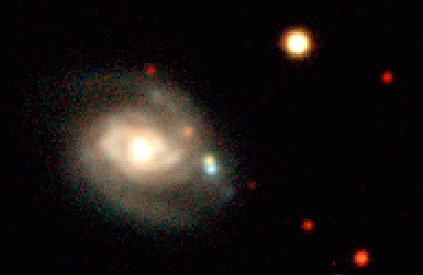Explanation: Long ago in a galaxy far, far away, locked in their final desperate struggle against the force of gravity ... two stars exploded! stellar explosions - Supernovae - are among the most powerful events in the Universe, estimated to release an equivalent energy of up to 1 million trillion trillion (1 followed by 30 zeros) megatons of TNT. After the explosion, an expanding supernova envelope is observed to brighten over a a period of days to a maximum light output which rivals that of an entire galaxy before fading from view over the following months. Triggered by the collapsing core of a massive star or the nuclear demise of a white dwarf supernovae occur in average spiral galaxies only about once every 25-100 years. But a recent observation of NGC 664, a spiral galaxy about 300 million light years distant, captured a rare and colorful performance - two supernovae from the same galaxy. In this monitoring exposure the two supernovae, one reddish yellow and one blue, form a close pair just below the image center (to the right of the galaxy nucleus). The color difference is due to temperature - blue is hotter.
1999 2000 2001 2002 2003 2004 2005 2006 2007 2008 2009 2010 2011 2012 2013 2014 2015 2016 2017 2018 2019 2020 2021 2022 2023 2024 2025 |
Январь Февраль Март Апрель Май Июнь Июль Август Сентябрь Октябрь Ноябрь Декабрь |
NASA Web Site Statements, Warnings, and Disclaimers
NASA Official: Jay Norris. Specific rights apply.
A service of: LHEA at NASA / GSFC
& Michigan Tech. U.
|
Публикации с ключевыми словами:
supernova - Сверхновые - гравитационный коллапс - белый карлик - далекие галактики
Публикации со словами: supernova - Сверхновые - гравитационный коллапс - белый карлик - далекие галактики | |
См. также:
Все публикации на ту же тему >> | |
